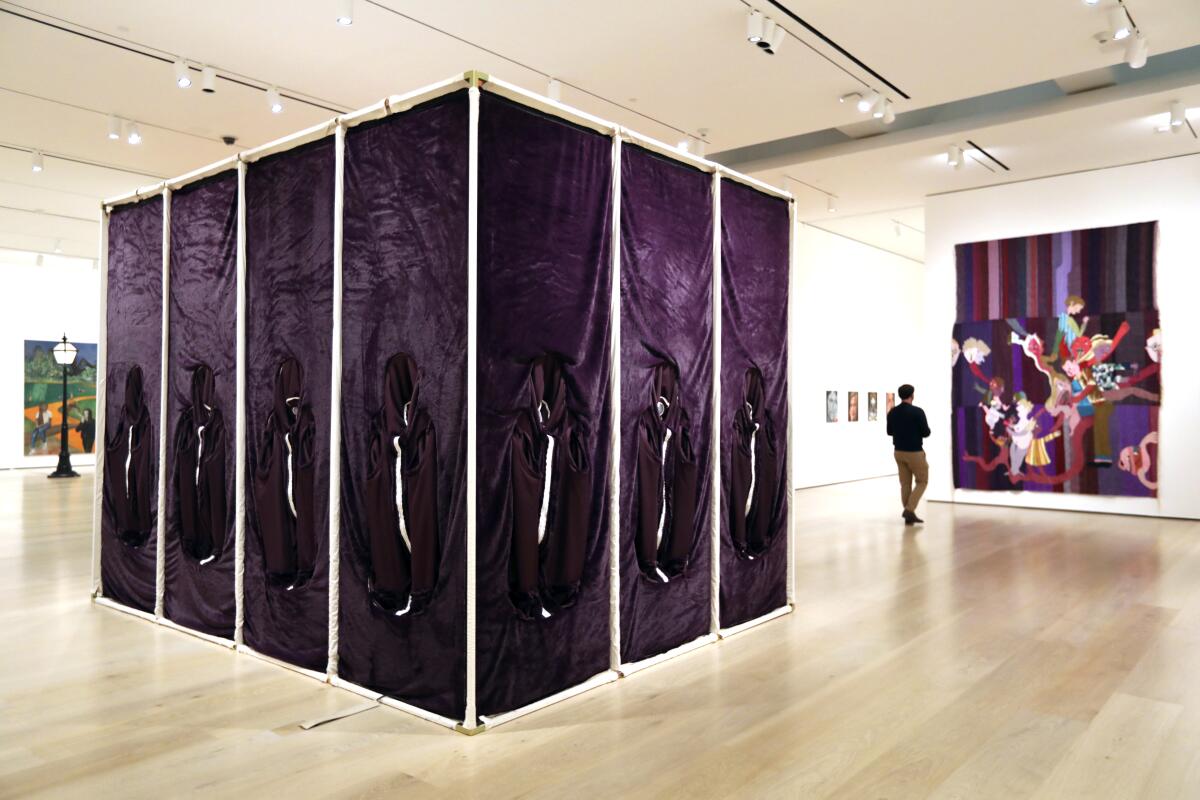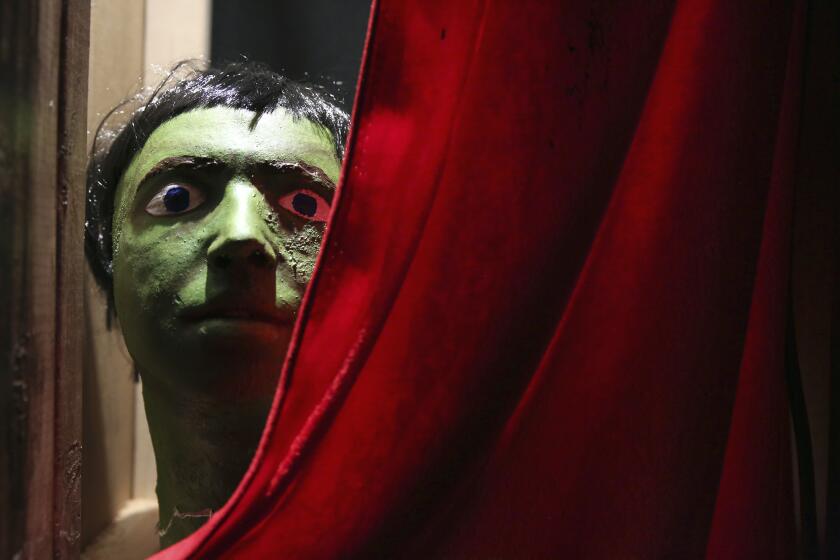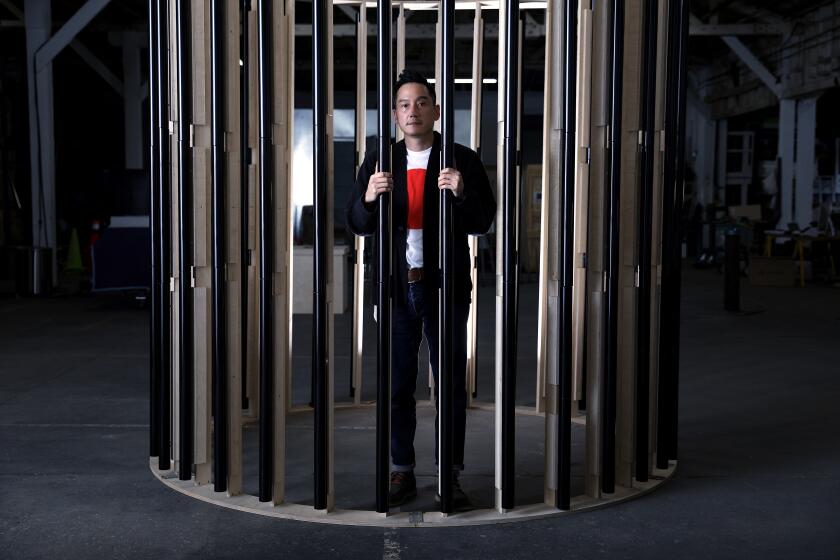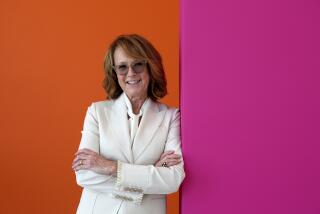One of L.A.’s most important art exhibitions is stuck in COVID-19 limbo

- Share via
The late French-Moroccan artist Nicola L’s 1969 sculptural installation “La Chambre en Fourrure” (The Fur Room), slathered in royal purple faux-fur and studded with pockets, has been re-created inside the Hammer Museum for this year’s “Made in L.A.” biennial. Before COVID-19, viewers were meant to slide their faces and arms into bodysuit-like sacs that hang limply on the exterior of the piece, “wearing” the work as if it were a costume. It was tweaked for the COVID-19 era, now viewable but not interactive — a powerful testament to art interrupted during the pandemic.
But you cannot wear it or even see it. Not yet, anyway.
“Made in L.A. 2020: a version” is fully installed at the Westwood museum and at the Huntington Library, Art Museum and Botanical Gardens in San Marino — a “cross-town art conversation” that’s easily the most ambitious Hammer biennial installation to date. But with the museums closed and awaiting permission from government health officials to reopen, the exhibition remains shuttered to the public. The works, by 30 emerging local artists, sit in empty galleries, a custom soundscape echoing in one room, a textile work gently rippling from the AC in another.
The biennial originally was supposed to premiere in June. There was hope of opening it in September, but the coronavirus wouldn’t have it. Two offsite outdoor public art projects debuted in late October, but the opening date for the indoor museum installations remains a bold question mark as COVID-19 case counts rise across the U.S.
“When can we reopen is not a question I can answer, except to say we hope it’s soon,” Hammer Museum representative Scott Tennent said. “We’re following the lead of the state and the county. We really want to share this exhibition with everyone — it’s ready — but until we’re actually told we can reopen, we’re in stasis.”
Abhorrence is an undercurrent of “Made in L.A.,” this year installed at the Hammer and the Huntington — both still waiting to reopen galleries closed by COVID-19.
The long waiting game is a maddeningly frustrating scenario that has many museums seeing red. Or, in L.A. County, purple.
On Aug. 28, the state issued its Blueprint for a Safer Economy plan, which introduced a color-coded system rating counties’ COVID-19 risk based on their case counts and test positivity rate.
L.A. County is in the purple or “widespread” tier, the highest risk category, which calls for museums, zoos and aquariums to close indoor operations. County officials might tighten but cannot loosen, those state restrictions. Were L.A. County to improve and inch into the red category, the state would allow museums to open at 25% capacity. For the Hammer, that would mean admitting 40 people per hour across 16,000 square feet of gallery space. With each new tier — orange is next, then yellow — the allowed capacity goes up.
What has the nonprofit California Assn. of Museums upset is the fact that under these same rules, shopping malls, retail stores, hair and nail salons and tattoo parlors are allowed to stay open in L.A. County while places such as the Hammer and the Huntington’s art galleries remain closed. The implication is that malls, nail salons and the like are somehow safer for the public than museums. And the ramifications are profound, not just for museumgoers missing out on culture and connection but for institutions losing revenue and for staffers who are furloughed or laid off. Through letters, phone calls and Zoom meetings, the association has called on California Department of Public Health officials and the office of Gov. Gavin Newsom to reconsider the rules.
“We see a discrepancy in how they’re applying the guidelines to similar risk environments,” CAM Executive Director Celeste DeWald said. “We’ve been asking for parity with shopping malls.”
Neither the Hammer nor the Huntington have joined CAM’s efforts to lobby state officials.
“Our top concern is that Angelenos are safe and that COVID cases are declining,” Tennent said. “But that aside, if those other businesses can be cleared to open now and have demonstrated they can be safe, there’s no reason why museums couldn’t be expected to do the same.”
The Huntington also was sympathetic to the lobbying of state officials, said representative Susan Turner-Lowe. So why hasn’t it joined the effort?
“We’re deferring to the health officials and the scientific evidence,” she said. “In the end, this is a pandemic, a health crisis and we’re not the experts. We get that it’s super complicated.”
Our vigilance toward reopening malls amid COVID-19 should be accompanied by a willingness to adapt museums to have visitors again as well.
On Nov. 4 a letter signed by 27 state legislators went to the governor urging that museums in the purple tier be allowed to reopen at 25% capacity as long as they were following safety protocols.
“Not only do these spaces benefit the mental health and emotional needs of Californians who walk through their doors,” the letter read, “they also foster a deeper understanding of our shared human heritage and connect us all at a time when we are often unable to share in meaningful contact with one another.”
The Blueprint for a Safer Economy’s risk-based criteria include the ability to accommodate mask wearing and social distancing, to provide well ventilated spaces, to limit duration of exposure and to limit the mixing of people from different households and communities.
Acting state public health officer Dr. Erica S. Pan sent a letter to CAM on Oct. 9 that stated shopping malls attract largely local patrons, whereas museums attract tourists from many different areas, potentially raising the transmission risk. Museum-goers, the California Department of Public Health surmised, generally spend longer periods of time looking at artworks in galleries, compared with quicker transactional interactions in malls.
“Museums and shopping malls,” Dr. Pan wrote in the letter, “despite their similarities, actually produce different sources of risk.”
Neither Dr. Pan nor anyone else in her office was available for an interview. In an email exchange, the state health department did not answer a Times inquiry asking if it had data showing that shopping centers were any less of a tourist magnet than museums, especially in Southern California. Malls such as the Beverly Center and Westfield Santa Anita are international tourist destinations, and tourist buses at places such as Rodeo Drive or the Grove would indicate stores there have the potential to draw just was many out-of-town visitors as museums. The health department said that its tiered system for reopenings “considers epidemiological conditions and the latest understanding of transmission risk in certain sectors.”
“A lot of presumptions are being made about how people use museums and the time spent there,” DeWald said. “It’s pretty clear we’re feeling, as a sector, that the decisions they’re making about what can be open and not is disproportionately affecting the museum sector.”
In 2019, 75% of the Hammer’s visitors were local. At the Huntington, 40% are typically local — but during the pandemic, with fewer people traveling, the number has been 65%.
“L.A. museums really do cater to Angelenos,” Tennent said. “This idea that museums somehow pose a risk because they may attract people from further away, I’m not sure how much the data supports that.”
Readying “Made in L.A.” for its eventual opening, the Hammer and Huntington have prepared safety protocols including timed reservations, a mask mandate, one-way paths through exhibitions and hand-sanitizing stations. Until then, Tennent said, the museums will continue to showcase aspects of “Made in L.A.” — videos, performances, an imminent podcast — online.
“That doesn’t take the place of experiencing an exhibition in person,” Tennent said, “so we’re still very hopeful that we’ll have the opportunity to open our doors and let people see this exhibition. We’re taking it a week at a time.”
L.A.’s Glenn Kaino has a new doc about activist-Olympian Tommie Smith, a Mass MoCA show and magical new sculpture that you have to see to believe.
But if the coronavirus spikes through spring and a vaccine isn’t widely available yet, what happens? “Made in L.A.” fills all of the Hammer’s galleries, but it is planning to present an Andrea Bowers survey exhibition in June and will need space.
The Huntington said it has more flexibility but is still gravely considering the future.
“With COVID numbers on the rise, it’s spurred conversations about what are we thinking with respect to dates?” said Turner-Lowe, who was already looking ahead to early 2021. “How far can we push it into the new year? We have flexibility in our galleries, but we’ll see.”
So is there a chance the museums may never show this year’s biennial in person?
“I really hope not,” Tennent said. “We’re doing all we can as a museum and as a public space to make sure people have a safe experience. But that’s ultimately a question of how California and Los Angeles handle the pandemic.”
More to Read
The biggest entertainment stories
Get our big stories about Hollywood, film, television, music, arts, culture and more right in your inbox as soon as they publish.
You may occasionally receive promotional content from the Los Angeles Times.













